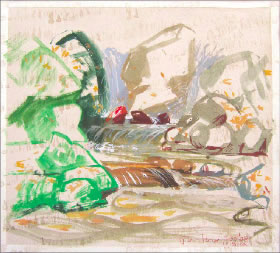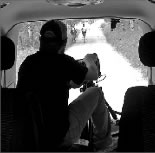by Philip Tarlow
Editor’s note: This story originally ran in the January 2009 issue of the Crestone Eagle.
The sky turned deep purple-gray as I sat by Cottonwood Creek. Hailstones began raining down on my head, bouncing off my painting surface; watercolor paper taped to a piece of plywood.
The spring runoff roared, virgin pale green leaves shook, water leapt and splashed on ancient rocks. New moisture released fragrances from the earth and foliage that made you swoon. I was in heaven; why get up just because a bit of hail was falling? The tempo increased and I was in a hailstorm. I reluctantly packed up and returned home, imagining myself the brave warrior.
The mosquitoes kicked in sometime in early June. I bought a netted jacket. Painting while looking through the netting was almost impossible and very annoying, until I got that it was actually discouraging my habitual attention to detail and tendency to want to make a rock look like a photo of a rock. I became so completely attached to painting while looking through that web of nylon, and to that out of control feeling, that I imagined never being satisfied painting without it.

One day, I placed my chair precariously and fell over backwards as I was working. Another, my entire palette was blown into the creek; my glass water jar fell and shattered on a rock; my favorite brush slipped into the creek and was instantly swept away; I was surprised by a woman who suddenly appeared in my peripheral vision and I literally jumped a foot out of my chair; dogs made unannounced appearances; and the bears, who had sharpened their claws on the aspen bark, lurked not far off.
Unexpectedly, at odd intervals, a figure would descend the steep path on the opposite side of the creek, no more than 50 feet from me, to do a puja or sit in meditation at the creekside shrine. Each was engaged in a meditative practice; while we was aware of one another’s presence, no words were exchanged. Very dream-like.
Just a few of the stories that make up the adventure and thrill of painting outdoors. I have, over the years, done a lot of it, especially in Greece. But I have never made so many paintings on site, of the same exact landscape, facing the exact same direction.
On most days, I would make three or four at a sitting. Each day’s work is reflective of a different mood, a different set of weather and light conditions and other intangibles. As of today, there are well over 100 small paintings.
I guess you could say these are “biomorphic” abstractions. However far I have departed from the realistic depiction of, say, rushing water, the origin and inspiration of the gesture my hand makes and the mark left by the brush derives from the observation and experience of the actual physical rushing water.
Sitting in the same spot day in day out, I began practicing what I had always dreamed of; I found myself inventing signs, shorthand, for water, rocks, foliage. And my favorite area of art history, neolithic pots and wall paintings and aboriginal art began to come alive in my awareness. I realized I was painting the energy.
At times I fancied myself one of my Chinese or Japanese heroes, itinerant 11th Century monks who left their positions in the city as public servants, sometimes due to regime change. They would wander the vast and pristine wilderness and make paintings and scrolls of mountains, rivers and forests, sometimes sitting in one spot for days before lifting their brush to paint. “Less is more” seemed to be their credo, and the best of the work derives from a meditative space. The outcome, however, the marks themselves, can be wild, crazy, outrageous. No paradox there. Wine was frequently involved.
The work was all done in gouache on Saunders watercolor paper. As the months went by, I began recording not only the date but the time each piece was done. I’ve made a selection, and some will be shown individually, others in groupings of two paintings made the same day.
Cottonwood Creek, and especially this particular spot, has given me more than I can say. As a way of giving back, 40% of the proceeds of any sales will be donated to the Water Protection Coalition.
Crestone artist Philip Tarlow can be reached by e-mail at tarlowbusiness@gmail.com


